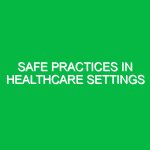Introduction
Food safety in the workplace is a critical aspect of the Health, Safety, and Environment (HSE) domain. It encompasses practices that ensure food is handled, prepared, and stored in a manner that prevents foodborne illnesses and contamination. Every organization that deals with food, whether it’s a restaurant, a corporate cafeteria, or a food manufacturing plant, must prioritize food safety. The implications of neglecting this responsibility can be severe, leading to health risks for employees and customers alike, alongside potential legal consequences for the business.
Consider the story of a local diner that neglected to implement basic food safety measures. A few weeks into summer, a wave of food poisoning cases linked back to their kitchen surfaced. The diner faced not only financial losses but also reputational damage that took years to recover from. This example underscores the importance of a proactive approach to food safety in the workplace. In this article, we will explore the hazards associated with food safety, best practices, and the regulations that govern this essential area.
Understanding the Hazards and Risks
Food safety hazards can be broadly categorized into three types: biological, chemical, and physical. Each category presents unique challenges that can compromise food safety.
Biological Hazards
Biological hazards are perhaps the most significant risk in food safety. These include bacteria, viruses, and parasites that can contaminate food. Common culprits include Salmonella, E. coli, and Listeria, which can lead to serious health issues. For instance, a case study from the CDC reported a significant outbreak of E. coli linked to undercooked beef served at a fast-food chain. Such incidents highlight the need for thorough cooking and handling procedures.
Chemical Hazards
Chemical hazards arise from the presence of harmful substances in food, whether they originate from pesticides, cleaning agents, or food additives. For example, a cleaning solution accidentally mixed into a food preparation area can lead to severe health consequences. A notable incident involved a school cafeteria where improper storage of cleaning chemicals resulted in their contamination of food items, leading to multiple hospitalizations. This emphasizes the importance of proper training and labeling of chemicals used in food-related environments.
Physical Hazards
Physical hazards include foreign objects in food, such as metal shards, glass, or plastic. These can cause choking or injuries. An example is a manufacturing plant that failed to regularly inspect its machinery, leading to metal fragments contaminating a batch of canned goods. Such lapses can result in product recalls and serious legal implications.
Best Practices and Safety Precautions
Creating a safe food environment in the workplace requires a commitment to best practices and safety precautions. Here are some actionable strategies to mitigate the risks associated with food safety.
Implementing Proper Hygiene Practices
Personal hygiene is the first line of defense against foodborne illnesses. Employees should wash their hands regularly, especially before handling food, after using the restroom, and after touching potentially contaminated surfaces. Training staff on proper handwashing techniques can significantly reduce the risk of contamination. For instance, a quick demonstration on how to wash hands effectively can reinforce this critical practice.
Temperature Control
Temperature control is vital in preventing the growth of harmful bacteria. The USDA recommends keeping hot foods at temperatures above 140°F (60°C) and cold foods below 40°F (4°C). Regularly monitoring these temperatures with calibrated thermometers can prevent potential hazards. For example, a restaurant that habitually checks its refrigerator temperatures can avoid the risk of spoilage and foodborne illness, ensuring a safer dining experience for customers.
Safe Food Handling Techniques
Training employees on safe food handling techniques is essential. This includes understanding the importance of separating raw and cooked foods to prevent cross-contamination. For instance, a chef should always use separate cutting boards for raw meat and vegetables. This simple practice can drastically reduce the risk of foodborne illnesses.
Effective Cleaning Procedures
Establishing effective cleaning and sanitizing procedures is crucial. Surfaces that come into contact with food must be cleaned and sanitized regularly. A systematic cleaning schedule, combined with employee training on proper cleaning techniques, can help maintain a hygienic environment. For instance, a food processing plant that implements a strict cleaning regimen can significantly lower its risk of contamination.
Regular Training and Education
Continuous training and education on food safety practices are vital. Regular workshops and refreshers can keep employees informed about the latest safety protocols and regulations. For example, a corporate cafeteria might hold quarterly training sessions to reinforce best practices, ensuring that all staff are aware of their responsibilities regarding food safety.
Regulations and Standards in Food Safety
Numerous regulations and standards govern food safety in the workplace. Understanding these frameworks is essential for compliance and the overall safety of food handling operations.
Food Safety Modernization Act (FSMA)
The Food Safety Modernization Act (FSMA), implemented by the FDA, emphasizes the prevention of food safety hazards rather than responding to them after they occur. This act requires food businesses to analyze potential hazards and implement preventive controls to mitigate risks. Businesses must also maintain detailed records of their food safety practices.
Hazard Analysis Critical Control Points (HACCP)
HACCP is a systematic preventive approach that identifies and controls hazards throughout the food production process. By implementing HACCP principles, businesses can significantly reduce risks associated with food safety. For instance, a bakery that follows HACCP guidelines meticulously checks every stage of its production, from ingredient sourcing to final packaging, ensuring that each product is safe for consumption.
Local Health Regulations
Local health regulations vary by region but generally require food establishments to adhere to specific safety practices. Regular inspections by health departments help ensure compliance with these regulations. A restaurant that actively engages with local health authorities can stay informed about best practices and avoid potential violations.
Conclusion
Food safety in the workplace is an integral component of health and safety management. By understanding the hazards, implementing best practices, and adhering to regulations, organizations can create a safer environment for both employees and customers. The importance of proactive food safety measures cannot be overstated; they not only protect public health but also enhance the credibility and success of a business. By fostering a culture of food safety, companies can mitigate risks and build a reputation for excellence in their food handling practices.
As we navigate the complexities of food safety, let us remember that it is not merely a set of rules but a commitment to safeguarding health and well-being in everything we serve. By prioritizing food safety, workplaces can ensure that every meal is a safe meal.


